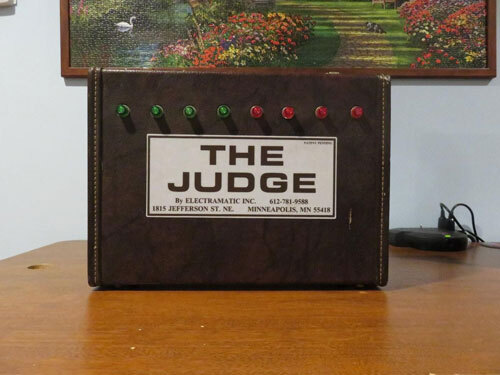
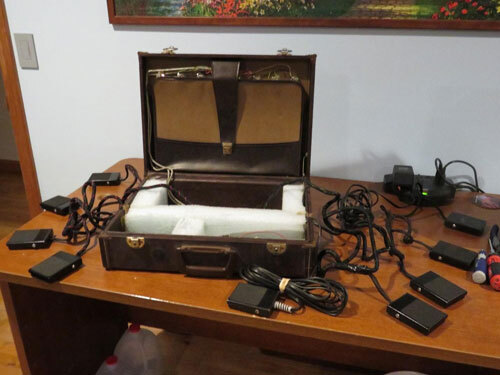
“The Judge” opened and closed. Notice the bomb-like case and unusual foot pedal buzzing units (Joe Feldman/Long Island QB)
Suitcase buzzers, wikis and PlayStation controllers: a brief history of quizbowl and technology
Producing, running and playing a quizbowl tournament is a blend of both high and low technology. The following is a concise survey of how quizbowl has and has not kept up with the digital age.
Quizbowl buzzers, the devices that indicate who rang in first on a tossup question, remain bespoke and relatively low tech. The most notorious set of buzzers is “The Judge” (shown above) which is an unusual combination of foot petals, lights, and a briefcase. What it most closely resembles is a bomb prop in old movies and has been known to cause issues when going through airport security. The Judge has a reputation for being the most reliable buzzer system. Having played on several broken Judges, I’m of the opinion this reputation is completely unearned.
At least four people (including myself) have independently written software that converts buzz controllers originally designed for the Buzz series of games on the PlayStation 2 to work in the quizbowl format. These buzzers conveniently use a standard USB port.
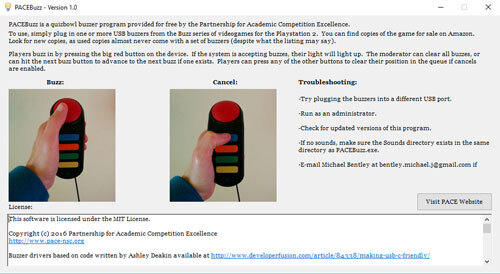
About screen from PACEBuzz, quizbowl software for PlayStation 2 buzzers.
Reading questions and keeping score often remains stubbornly low tech. National quizbowl tournaments all still rely on paper packets of questions and hand-written scoresheets. Stats moved from hand calculation to software in the late ’90s, but the most common stats program, SQBS, hasn’t evolved much since the early 2000s as you might notice from the retro interface in the below screenshot.

SQBS (“Sewell’s Quiz Bowl Statistics”): The standard for quizbowl stats since the early 2000s
Question writing is the area that has changed the most due to technological advances. The earliest independent college tournaments in the 1980s tasked each team with writing a packet of questions. In these days before the widespread availability of word processors—much less Google or Wikipedia—questions were usually written from encyclopedias, typed on typewriters, and then physically mailed to tournament editors who’d (literally) copy and paste packets before xeroxing them.
The questions were short, usually no more than 2 or 3 sentences. Here’s an example from the 1982 National Invitational Tournament, one of the first independent college tournaments:
Compare this to a tossup on the same subject from the 2019 iteration of the Early Fall Tournament, an event targeted at newer collegiate players:
What changed in the intervening 37 years?
For one, it became a lot easier to do in-depth research from your room. No longer was a trip to the university library required to request a biography on Andrew Jackson. This type of information could now be found in a multimedia encyclopedia like Encarta. (I still use an out-of-print DVD version of Encyclopedia Britannica when I want to write questions but not pay for Wi-Fi on flights.) By the early 2000s, internet resources such as Google, Wikipedia, Google Books, JStor and more let writers go much deeper much quickly into a topic. I no longer necessarily need to read the Mayan epic the Popol Vuh in its entirety to find a passage from it that could be used for a “common link” question on blood in world mythology.
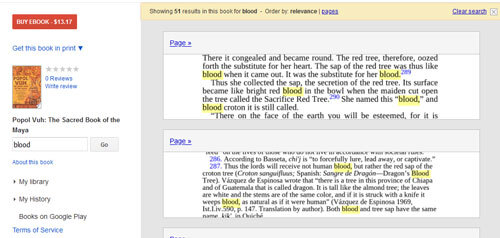
An example Google Books search for “blood” in the Mayan epic Popol Vuh. This edition lacks an index. Without a search engine, finding references to “blood” in the text would be extremely laborious.
Equally important, archives of questions from old tournaments moved from stacks of boxes in someone’s dorm room to being freely available online. This means that I can search all previous questions on Andrew Jackson to assess the difficulty of each clue in my new Jackson question. (Repeating exact clues is a big no-no, but the same subjects do come up again and again across quizbowl tournaments.)
The logistics of writing a 16-packet (640 question) question set were also improved through technology. In the mid-2000s, some question writing teams started using MediaWiki (the same software that powers Wikipedia) to collaboratively edit packets. The rise of tools like Google Docs made this even easier. Specialized question writing software was also developed.
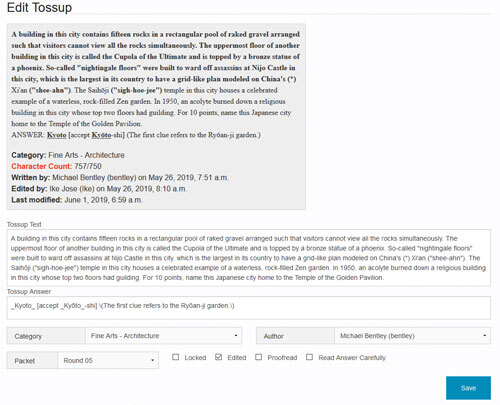
A screenshot from QEMS2, an online manager for collaborative question writing
You may be wondering: Did the questions just get harder? Is anyone actually buzzing on these early clues? Yes, clues in tossup questions definitely got harder since the early days of quizbowl (although the answer lines arguably have gotten easier). But tech has allowed the best quizbowl players to get even better. Quizbowl’s elite players are routinely reading questions from old tournaments on the question archives. They’re using powerful flashcard software like Anki to make thousands of flashcards of clues that have come up before. They’re listening to recordings of old matches. They’re having bots read questions to them. All these options weren’t available, at least at this level, as recently as 20 years ago.
Technological changes have also brought changes in how the quizbowl community keeps in touch with each other. Physical mailing lists gave way to webrings and a Yahoo! group. The Yahoo! group fell out of fashion and was largely replaced with hsquizbowl.org, originally a forum for high school quizbowl that now covers all levels of the game. Younger members of the community have moved to social platforms like Facebook Groups, Discord servers, and others I’m too old to know about. There’s even the QBWiki which documents quizbowl achievements and terminology.